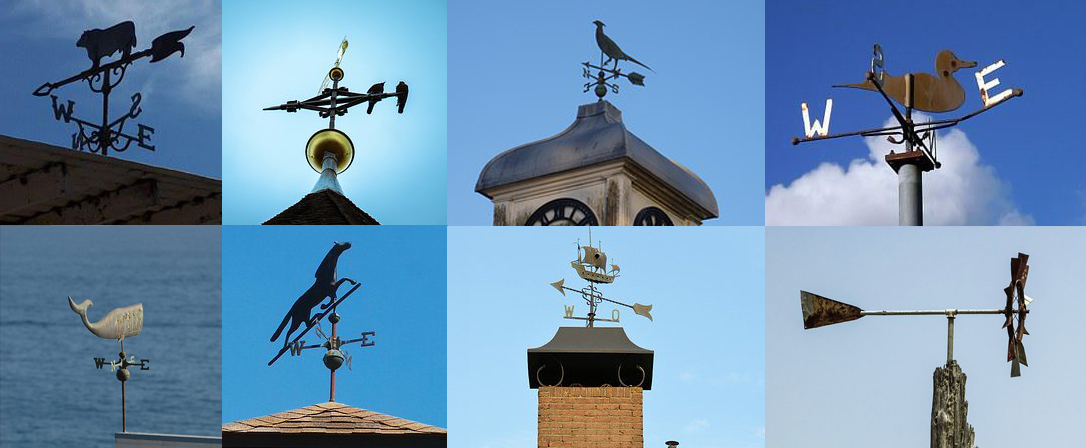Weathercock
A weathercock, weathervane or wind vane is a rotating device installed at the top of a building to indicate the direction of the wind.
The first documented weathervane was a two and a half metre long bronze cast depicting the god Triton, installed on The Tower of the Winds near the Acropolis in Athens in around 48 B.C. Other weathervanes during this time include a copper horsemen in Syria and a human figure in Constantinople. References to weathervanes mounted on buildings appear in De Architectura, by the Roman author and architect Vitruvius in the 1st-century, whilst the oldest surviving weathervane, the Gallo di Ramperto from the 9th-century is found in the Museo di Santa Giulia, Brescia, Italy.
Although, the earliest recorded British weathercock was erected on the tower of Winchester Cathedral in the 10th century, and the oldest weathercock still functioning in England can be found on the church in Ottery St. Mary, Devon and dates from about 1340, it is generally accepted weather cocks existed in England before then. The Anglo-saxons for example, from as early as around the 8th Century, made reference to weathercocks in a famous riddles of the time.
'I have a puffed-out breast and a swollen neck; I have a head and a tall tail; I have eyes and ears, and a single foot, a rough hard bill, and a long neck and two sides; hollow in the middle. My home is over men. I suffer, much whenever he moves me, who stirs the forest, and rains and hard hail beat on me as I stand, and frost freezes and snow falls on me, hollow-bellied...'
There was proliferation of weathercocks across Europe in the 9th century due to a papal edict that required every Church in Christendom to be mounted by a cockerel, a symbol to recall Peter's betrayal of Christ (LUKE 22:34) "I tell thee, Peter, the cock shall not crow this day, before that thou shalt thrice deny that thou knowest me". By the 13th century the word for weathercock and weathervane had become interchangeable, but royal licence was required for the use of a weathervane.
By the 14th century, dolphins, fish, griffins and dragons might have been seen, and by the Middle Ages, a coat of arms. Tudor weathervanes of the 15th and 16th century, may have had a stone beast, holding a rod with a banner-like vane mounted upon it, 12 of which were recorded as having been located on the Manor House at Stanton Harcourt, Oxfordshire. By the 18th century copper weathervanes in England almost entirely gave way to wrought iron flat silhouettes.
By the Victorian age, where ornament was celebrated, weathervanes along with or designed into windcowls, as well as sundials would have been common sights, and by the 19th century, the subjects of the weathervane somewhat exploded with exotic animals and mythical creatures, sporting motifs, and even trade signs being mass produced in cast iron.
[edit] Related articles on Designing Buildings
- Cross ventilation.
- Energy targets.
- Face velocity.
- Types of ventilation.
- Ventilation.
- Wind.
- Wind cowl
- Wind turbine.
- Sundial.
- Medieval architecture
[edit] Related external links
Featured articles and news
Latest Build UK Building Safety Regime explainer published
Key elements in one short, now updated document.
UKGBC launch the UK Climate Resilience Roadmap
First guidance of its kind on direct climate impacts for the built environment and how it can adapt.
CLC Health, Safety and Wellbeing Strategy 2025
Launched by the Minister for Industry to look at fatalities on site, improving mental health and other issues.
One of the most impressive Victorian architects. Book review.
Common Assessment Standard now with building safety
New CAS update now includes mandatory building safety questions.
RTPI leader to become new CIOB Chief Executive Officer
Dr Victoria Hills MRTPI, FICE to take over after Caroline Gumble’s departure.
Social and affordable housing, a long term plan for delivery
The “Delivering a Decade of Renewal for Social and Affordable Housing” strategy sets out future path.
A change to adoptive architecture
Effects of global weather warming on architectural detailing, material choice and human interaction.
The proposed publicly owned and backed subsidiary of Homes England, to facilitate new homes.
How big is the problem and what can we do to mitigate the effects?
Overheating guidance and tools for building designers
A number of cool guides to help with the heat.
The UK's Modern Industrial Strategy: A 10 year plan
Previous consultation criticism, current key elements and general support with some persisting reservations.
Building Safety Regulator reforms
New roles, new staff and a new fast track service pave the way for a single construction regulator.
Architectural Technologist CPDs and Communications
CIAT CPD… and how you can do it!
Cooling centres and cool spaces
Managing extreme heat in cities by directing the public to places for heat stress relief and water sources.
Winter gardens: A brief history and warm variations
Extending the season with glass in different forms and terms.
Restoring Great Yarmouth's Winter Gardens
Transforming one of the least sustainable constructions imaginable.























